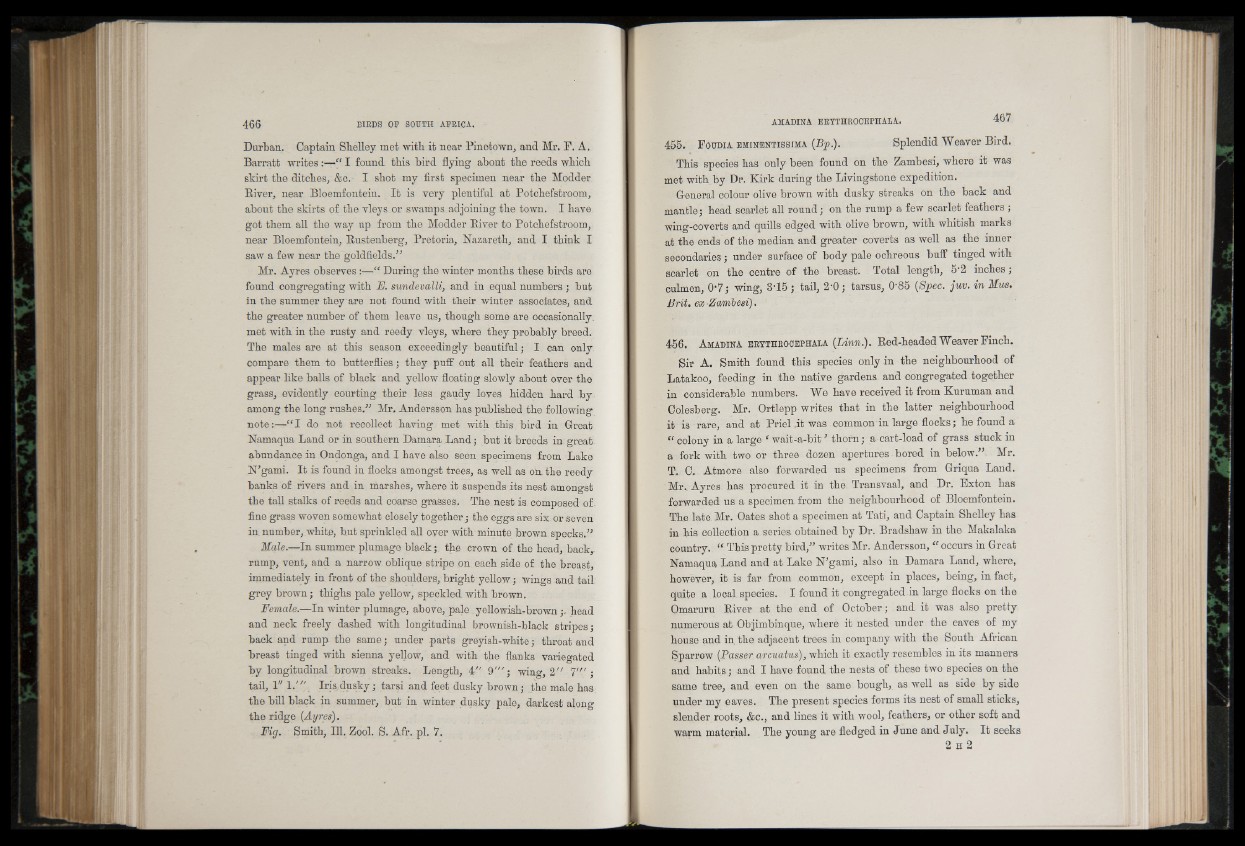
Durban. Captain Shelley met with it near Pinetown, and Mr. F. A.
Barratt writes:—“ I found this bird flying about the reeds which
skirt the ditches, &c. I shot my first specimen near the Modder
River, near Bloemfontein. I t is very plentiful at Potchefstroom,
about the skirts of the vleys or swamps adjoining the town. I have
got them all the way up from the Modder River to Potchefstroom,
near Bloemfontein, Rustenberg, Pretoria, Nazareth, and I think I
saw a few near the goldfields,”
Mr. Ayres observes:—“ During the winter months these birds are
found congregating with E. sundevalli, and in equal numbers ; but
in the summer they are not found with their winter associates, and
the greater number of them leave us, though some are occasionally,
met with in the rusty and reedy vleys, where they probably breed.
The males are at this season exceedingly beautiful; I can only
compare them to butterflies; they puff out all their feathers and
appear like balls of black and yellow floating slowly about over the
grass, evidently courting their less gaudy loves hidden hard by.
among the long rushes.” Mr, Andersson has published the following
note:—“ I do not recollect having met with this bird in Great
Namaqua Land or in southern Damara Land; but it breeds in great,
abundance in Ondonga, and I have also seen specimens from Lake
N’gami. It is found in flocks amongst trees, as well as on. the reedy
banks of rivers and in marshes, where it suspends its nest amongst
the tall stalks of reeds and coarse grasses. The nest is composed affine
grass woven somewhat closely together ; the eggs are six or seven
in. number, white, but sprinkled all over with minute brown specks.”
Male.—In summer plumage black; the crown of the head, back,,
rump, vent, and a narrow oblique stripe on each side of the breast,
immediately in front of the shoulders, bright yellow; wings and tail,
grey brown; thighs pale yellow, speckled with brown.
Female.—In winter plumage, above, pale yellowish-brown;. head
and neck freely dashed with longitudinal brownish-black stripes;
back and rump the same; under parts greyish-white; throat and
breast tinged with sienna yellow, and with the flanks variegated
by longitudinal brown streaks. Length, 4" 9 " '; wing, 2" 7 '" ;
tail, Iris,dusky; tarsi and feet dusky brown; the male has;
the bill black in summer, but in winter dusky pale, darkest along
the ridge (Ayres).
Fig. Smith, 111, Zool. S. Afr. pi. 7.
455. F o u d ia EMiNENTissrMA (Bp.). Splendid Weaver Bird.
This species has only been found on the Zambesi, where it was
met with by Dr. Kirk during the Livingstone expedition.
General colour olive brown with dusky streaks on the back and
mantle; head scarlet all round; on the rump a few scarlet feathers ;
wing-coverts and quills edged with olive brown, with whitish marks
at the ends of the median and greater coverts as well as the inner
secondaries; under surface of body pale ochreous buff tinged with
scarlet on the centre of the breast. Total length, 5-2 inches;
culmen, 0-7; wing, 3T5; tail, 2-0; tarsus, 0-85 (Spec. juv. in Mus.
Brit, ex-Zambesi).
456. A madina er t th ro c e ph a la (Linn.). Red-headed Weaver Finch.
Sir A. Smith found this species only in the neighbourhood of
Latakoo, feeding in the native gardens and congregated together
in considerable numbers. We have received it from Kuruman and
Oolesberg. Mr. Ortlepp writes that in the latter neighbourhood
it is rare, and at P rielitwas common in large flocks; he found a
“ colony in a large ‘ wait-a-bit5 thorn; a cart-load of grass stuck in
a fork with two or three dozen apertures bored in below.” - Mr.
T. C. Atmore also forwarded us specimens from Griqua Land.
Mr. Ayres has procured it in the Transvaal, and Dr. Exton has
forwarded us a specimen from the neighbourhood of Bloemfontein.
The late Mr. Oates shot a specimen at Tati, and Captain Shelley has
in his collection a series obtained by Dr. Bradshaw in the Makalaka
country. “ This pretty bird,” writes Mr. Andersson, “ occurs in Great
Namaqua Land and at Lake N’gami, also in Damara Land, where,
however, it is far from common, except in places, being, in fact,
quite a local species. I found it congregated in large flocks on the
Omaruru River at the end of October; and it was also pretty
numerous at Objimbinque, where it nested under the eaves of my
house and in. the adjacent trees in company with the South African
Sparrow (Passer arcuatus), which it exactly resembles in its manners
and habits; and I have found the nests of these two species on the
same tree, and even on the same bough, as well as side by side
under my eaves. The present species forms its nest of small sticks,
slender roots, &c., and lines it with wool, feathers, or other soft and
warm material. The young are fledged in June and July. I t seeks
2 H 2